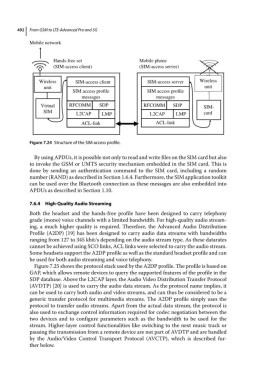Page 506 - From GMS to LTE
P. 506
492 From GSM to LTE-Advanced Pro and 5G
Mobile network
Hands-free set Mobile phone
(SIM-access client) (SIM-access server)
Wireless SIM-access client SIM-access server Wireless
unit unit
SIM access prole SIM access prole
messages messages
Virtual RFCOMM SDP RFCOMM SDP SIM-
SIM L2CAP LMP L2CAP LMP card
ACL-link ACL-link
Figure 7.24 Structure of the SIM access profile.
By using APDUs, it is possible not only to read and write files on the SIM card but also
to invoke the GSM or UMTS security mechanism embedded in the SIM card. This is
done by sending an authentication command to the SIM card, including a random
number (RAND) as described in Section 1.6.4. Furthermore, the SIM application toolkit
can be used over the Bluetooth connection as these messages are also embedded into
APDUs as described in Section 1.10.
7.6.4 High‐Quality Audio Streaming
Both the headset and the hands‐free profile have been designed to carry telephony
grade (mono) voice channels with a limited bandwidth. For high‐quality audio stream-
ing, a much higher quality is required. Therefore, the Advanced Audio Distribution
Profile (A2DP) [19] has been designed to carry audio data streams with bandwidths
ranging from 127 to 345 kbit/s depending on the audio stream type. As these datarates
cannot be achieved using SCO links, ACL links were selected to carry the audio stream.
Some headsets support the A2DP profile as well as the standard headset profile and can
be used for both audio streaming and voice telephony.
Figure 7.25 shows the protocol stack used by the A2DP profile. The profile is based on
GAP, which allows remote devices to query the supported features of the profile in the
SDP database. Above the L2CAP layer, the Audio Video Distribution Transfer Protocol
(AVDTP) [20] is used to carry the audio data stream. As the protocol name implies, it
can be used to carry both audio and video streams, and can thus be considered to be a
generic transfer protocol for multimedia streams. The A2DP profile simply uses the
protocol to transfer audio streams. Apart from the actual data stream, the protocol is
also used to exchange control information required for codec negotiation between the
two devices and to configure parameters such as the bandwidth to be used for the
stream. Higher‐layer control functionalities like switching to the next music track or
pausing the transmission from a remote device are not part of AVDTP and are handled
by the Audio/Video Control Transport Protocol (AVCTP), which is described fur-
ther below.

